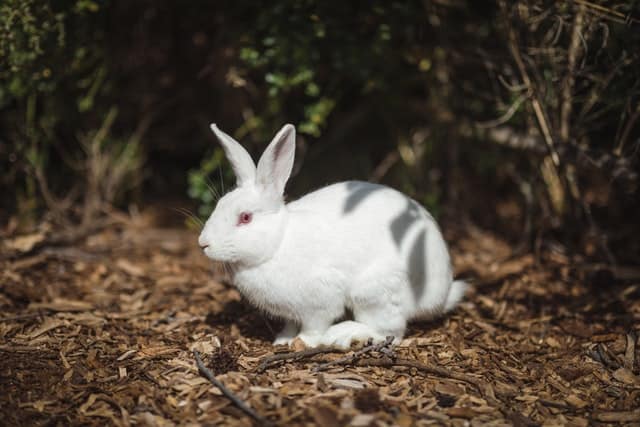
Do you know that hairballs in your rabbit’s stomach are considered one of the most serious ailments, and can endanger the life of your pet?. Like cats, rabbits lick their hair to groom their coat. A simple and usual ball of fur can end the life of your bunny.
Very recently we noticed that Tambor was strange, listless, it did not eat and hardly drank, it did not want our company and also did not poop. We immediately took it to its vet who told us he had hairballs in its stomach. He performed an X-ray to verify the presence of the hairball and applied the treatment.
A rabbit cannot go long without eating, so your agility and attention will be essential to save its life.
What are hairballs?
It is technically known as a trichobezoar, a type of bezoar, it is basically a collection of hairs in the digestive tract. As we cannot prevent a rabbit from swallowing hair (it licks it constantly to clean itself) we must pay special attention to its feeding and brush it continuously.
Unlike cats, rabbits are not physically capable of vomiting the contents of their stomachs. For this reason, anything that enters a rabbit’s mouth must be able to pass through the digestive tract.
Causes of hairballs in a rabbit’s stomach:
- The stomach is the most common part of the affected intestinal tract. If the rabbit is consuming a proper diet composed mainly of hay and other high fiber foods most of the hair will pass through the intestinal tract without causing damage. A low fiber diet, stress and fear can reduce gastrointestinal motility and also lead to accumulation of hair in the stomach and the formation of hairballs. In the prevention of the formation of hairballs, a diet rich in fiber is as important as the possibility that the animal lives in an environment suited to its ethological needs, free of stress and fear.
- Hair shedding is common in rabbits. Approximately every three months, although the most visible is in the seasonal changes, especially in autumn and summer. The shedding of hair is beneficial for them, as it helps them to regulate their body temperature, adapting the hair to the climatic needs, although it is at this time where they can ingest more hair.
How to prevent hairballs in rabbits?
Brushing
The daily brushing with a very thick brush is the best way to prevent trichobezoars.
To Brush your rabbit you must take care of it so that it does not escape or get hurt and start brushing from head to tail. There are some rabbits that must also be brushed around their faces, such as Lion’s head rabbits. In the case of this type of rabbit, we must take special care with the eyes so as not to harm them.
Your rabbit’s comb should be cleaned after each use and you should change it at least once every year or a year and a half. This is for hygienic reasons, but also so that the brush is in optimal condition and can perform well the function of removing dead hair on your scalp and also leave it with a soft and well-groomed coat.
feeding
The rabbit must consume hay every day. Since its great contribution in fiber redounds to the benefit of its regular intestinal transit, in addition to being the feeding base of the rabbit.
High fiber diets have been shown to greatly reduce the incidence of hairballs, this means that your rabbit should have plenty of hay at its disposal. Hay is the most important food in the rabbit’s diet, and must be served in unlimited quantities.
The fresh pineapple or papaya bits (1 or 2 times per week), are also suitable for evacuating the stomach hair balls.
Pineapple juice, pineapple or blended pineapple (we refer to natural pineapple, you should not eat pineapple in syrup, since sugar is not recommended). In addition to being rich in fiber, it contains Bromelain, an enzyme with proteolytic action (capable of breaking down proteins, an essential constituent of hair). It will help to undo the hairballs , being eliminated more easily. If your bunny is long-haired, give them about 2 ml. of pineapple juice 3 times a week. For shorter haired bunnies, 2ml once or twice a week will suffice.
With Tambor, the best thing that has worked for us is papaya. We usually give it to him in small pieces especially in times of molting (the days he has to eat fruit)
The use of malt for rabbits
If the rabbit is more than 3 months old, we can supply rabbit malt.
If you don’t like to eat it, which happens quite often, you should slather a leg with rabbit malt. The rabbit will lick this leg to remove the sticky matter, thereby indirectly eating the beneficial malt for rabbits. It will be cumbersome and we will not know the exact amount you eat, but it is an infallible method, because you will ingest it without realizing it when you groom yourself. As an advantage, the malt that is marketed for cats and rabbits is usually of different flavours, much more pleasant for our pet .
First of all, we must bear in mind that malt is used to prevent hairballs and not to eliminate them once they have formed. In case we make sure that our rabbit has hairballs in its stomach, we must go to the vet for another treatment.
When should I give my rabbit Malt?
We must give the malt every week to prevent the formation of these hairballs. Depending on whether we are in the shedding season, we must increase the dosage, and it will also depend on whether we are dealing with long or short haired rabbits:
Long Haired Rabbits
- Molting season: Every two days.
- Normal season: Twice a week and never on consecutive days.
Short Hair Rabbits
- Molting season: Three times a week and never on consecutive days.
- Normal season: Once a week.
Symptoms of the presence of hairballs in rabbits
If you suspect that your rabbit suffers the presence of hairballs or trichobezoars in their stomach, take note of the following symptoms:
- Swollen abdomen
- Doesn’t poop for days
- Refuses to eat
- Their stool comes out with attached hairs
Given these symptoms, you should go with your rabbit to the vet, since this ailment worsens very quickly.
What to do in case of hairballs in my rabbit’s stomach?
” Better safe than sorry.” However, if we suspect that our rabbit may have a hairball in its stomach, it is time to act without wasting a single minute.
A rabbit cannot go long without eating, so your agility and attention will be essential to save its life.
The first thing you have to do is try to get it to eat hay or natural pineapple. Fundamentally, it should only eat these two things, and we shouldn’t even leave them within its grasp. However, it is true that anything that our rabbit is willing to eat will be well received as long as its stomach does not remain empty for too long. In this last fatal case, you could go into intestinal stop. In case it does not eat and your vet is not available, we recommend that you give them critical care (with a syringe without a needle) and go to the vet as soon as possible.
Bunnies are very sensitive animals and that is why if your furry is sick or you think it may be, the best thing you can do is contact your exotics vet, never medicate it yourself.






